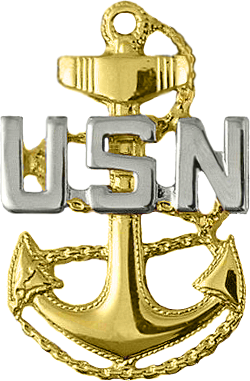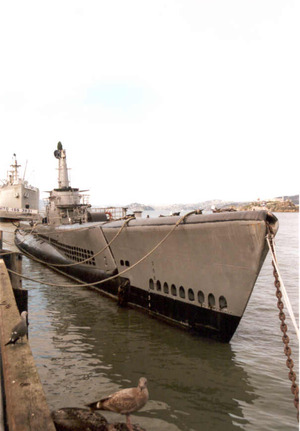

SS-383 Pampanito
SS-383 Pampanito
Country:  United States
United States
Class, [Type]: Balao, [SS].
Builder: Portsmouth Naval Shipyard, New Hampshire, U.S.A.
Launch date: 12 July 1943.
Commission date: 06 November 1943.
Decommission date: 15 December 1945.
Displacement ( tons ): 1.525 surfaced, 2.415 submerged.
Dimensions ( metres ): 95 x 8,3 x 4,7
Speed ( knots ): 23 surfaced, 11 submerged.
Range ( miles ): 11.000 at 10 knots ( surfaced ), 95 at 5 knots ( submerged ). Patrol endurance was 75 days.
Complement: 70 ( 10 officers ).
Guns: 1 x 127mm, 1 x 40mm, 1 x 20mm.
Torpedoes: 10 x 533mm tubes: 6 forward, 4 aft. 24 torpedoes: 16 forward and 8 aft.
Military lift: Fuel: 479tm.
Comment: Information taken from the Official Guide to the Museum: The USS PAMPANITO (SS-383) is a World War II fleet submarine built in 1943 at Portsmouth Naval Shipyard, New Hampshire. PAMPANITO is a Balao class submarine and made six patrols during World War II. She sank six Japanese ships and damaged four others, with a total of over 27,000 tons of enemy shipping sunk.
During her first two patrols PAMPANITO narrowly escaped destruction. While attacking an enemy convoy on the first patrol, PAMPANITO was spotted, severely depth charged and damaged. On PAMPANITO´s second patrol, while patrolling off the coast of Japan, alert lookouts spotted two torpedo wakes approaching allowing enough time to avoid them. Several days later another approaching torpedo was sighted. Evasive measures were taken and the torpedo crossed PAMPANITO´s bow missing by only a few yards.
During PAMPANITO´s third, and most well known, patrol she operated as part of a wolf-pack consisting of USS GROWLER ( SS-215 ) and USS SEALION II ( SS-315 ). On the morning of September 12th, 1944 the pack attacked a convoy carrying war production materials of oil and raw rubber. Unknown to the submarine skippers, the convoy also carried over 2,000 British and Australian prisoners of war. Many of the ships in the convoy were sunk by the pack including the two ships carrying the POWs. SEALION sank the RAKUYO MARU, which carried over 1,300 POWs, and PAMPANITO sank the KACHIDOKI MARU which carried 900 POWs. The three subs then left the area to pursue scattered ships in the convoy.
On September 15, PAMPANITO moved back to the area of the original attack and found men clinging to makeshift rafts. As the sub moved closer, the men were heard to be shouting in English. These men were the POW survivors of RAKUYO MARU sunk four days earlier by SEALION. PAMPANITO was able to pick up 73 men and called in three other subs in the area. SEALION picked up 54 men, QUEENFISH rescued 18 men and BARB rescued 14. Of the 1,300 men on RAKUYO MARU sunk by SEALION, 159 were rescued by the four subs. The Japanese rescued an additional 136 men for a total of 295 survivors. Of the 900 men on the KACHIDOKI MARU sunk by PAMPANITO, 656 men were rescued by the Japanese and taken to camps in Japan. Over 500 of these men were released by American troops at the end of the war.
PAMPANITO went on to make three more succesful patrols during the war before being retired from active service. Following the war she served as training ship for the Naval Reserve and was eventually transferred to The National Maritime Museum Association for public display. We are proud to offer the unique experience of a WW II submarine tour to the public as a lasting memorial to the Submarine Service of the US Navy.
Similar units:
 S31 Almirante García de los Reyes
S31 Almirante García de los Reyes S32 Isaac Peral
S32 Isaac Peral S33 Narciso Monturiol
S33 Narciso Monturiol S34 Cosme García
S34 Cosme García S35 Narciso Monturiol
S35 Narciso Monturiol
 Eugenio Castillo Pert
Eugenio Castillo Pert